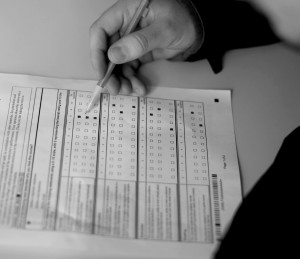Professors talk about student feedback

At the end of each semester, professors read evaluations completed by students who have taken their classes.
Professors look at the averages of both the numerical scores they are given and the comments that students leave. The comments section proves to be the most helpful in informing professors about how they are doing, but it can also be hurtful to read some of the comments students leave.
“I think sometimes students forget there is another human on the other end of it,” Dr. David Creech, assistant professor of religion, said. “Its surprising how mean people can be when its anonymous.”
Although Creech believes the evaluations can be very helpful if done in a thoughtful way, the anonymity of them allows students to comment whatever they want which in some cases means they can be mean or get back at a professor if they don’t like them.
“The positive comments are really fulfilling,” Creech said. “That rush is something that I enjoy. The problem is the negative ones. Those are the ones that stick. The ones that I remember and keep going back to are the ones that are negative. That becomes unpleasant.”
Creech compared the evaluations to tests and papers. He said that he gives students an honest evaluation of their performance.
“I’m upfront with students about how I perceive their performance, but they don’t have to be upfront with me about how they perceive my performance,” Creech said.
Creech would like a way to associate students with evaluations. He thinks departments or the registrar should associate students with a number; this number would connect students to their evaluation. He said this might help decrease personal attacks at teachers and increase the amount of constructive comments.
On the other hand Jeff Knight, assistant professor of graphic design, said he thinks keeping the students anonymous in the evaluations is good. It gives the students an opportunity to be honest about their thoughts on the class or the way a professor teaches it without having to worry about grades.
“I think it absolutely has to stay anonymous,” Knight said. “That’s the best way to do it.”
Knight also pointed out that criticism doesn’t always mean a student didn’t like the class. He said that when students choose to put something on the evaluation, it is something on their mind, so he will try to take those critiques into account.
“I use the evaluations as an assessment of understanding students perspective of the class,” Knight said.
When looking at the evaluations, Knight tries to understand them from the perspective of the student. He looks at comments and suggestions, and wonders whether it is something he can realistically correct. He said as long as it’s not a huge remaking of the syllabus, most of the suggestions are taken into account.
“You kind of have to pick and choose which ones will work and which ones won’t,” Knight said. “If you don’t like me as a person there’s not much I can do about that. If it’s an actual criticism of the class I’m absolutely going to take those into consideration.”
This is why Knight takes suggestions seriously. He looks at reoccurring content in people’s comments, being careful to not change too much of the syllabus based on one or two comments.
Similarly, Dr. William J. Snyder Jr., professor of English, said his curriculum changes are affected by trends. If he sees that multiple students make similar comments, that’s when he makes changes
Every two years, professors who do not have tenure are evaluated. Evaluations are optional for the year in between. Snyder, who has tenure, still chooses to hand out evaluations in order to get feedback from students and learn how to adjust the courses he teaches for the better.
“I use the numbers just to give me a sense of how I’ve done,” Snyder said. “They can be affirming too.”
Creech said when students give suggestions on how to make an issue better, it is easier to try to fix the problem. But when students simply complain about parts of the class, it’s hard to change things if there is not a clear direction as to what could improve.
“If students give me a concrete suggestion and it sounds good ill try it,” Creech said.
However, students also leave positive comments.
“What I get surprised at is the number of positive comments,” Creech said. “We’re all really self critical and sort of hammering ourselves. There’s still that sense of not expecting people to enjoy what you are doing.”
Positive comments reassure professors that aspect certain aspects of the course prove helpful for students.
“Positive comments help me continue doing what’s working,” Creech said. “Negative comments are often not the majority and usually they’re a bone to pick. You feel bad about it and think about it a lot. If it’s mean or snide, I just recognize that I didn’t connect with that student.”
Creech also said evaluations happen too late in the semester to implement any of the suggestions. He accommodates by handing out informal evaluations halfway through the semester to get immediate feedback from students.
Knight agreed, saying each class responds differently to each class; if he makes changes, they will be tested by a totally different class next semester. He also suggested department-specific evaluations, as there are so many differences between classes and how they should be evaluated.
“There’s kind of a blanket way the evaluations are done but everybody’s class is different,” Knight said.
Knight suggested there be a way to add specific questions from the professor to get a better feel for how that specific course went.
Professors receive the transcribed comments and averages of the number scores from the evaluations via email attachment about three to four weeks after the semester has concluded.
Creech finds that the evaluations are helpful for getting a sense of where he fits within the department. He likes to compare results with colleagues.
“You need to have data and you need to know how faculty are doing,” Creech said. “At that level they can be helpful. The really helpful part is the comments. It can help me think about the sort of classroom environment I’m creating.”





Be First to Comment